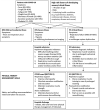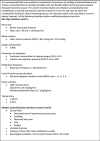Recommendations for Hospital-Based Physical Therapists Managing Patients With COVID-19
- PMID: 32556323
- PMCID: PMC7337861
- DOI: 10.1093/ptj/pzaa114
Recommendations for Hospital-Based Physical Therapists Managing Patients With COVID-19
Abstract
Objective: The COVID-19 pandemic is rapidly evolving and has led to increased numbers of hospitalizations worldwide. Hospitalized patients with COVID-19 experience a variety of symptoms, including fever, muscle pain, tiredness, cough, and difficulty breathing. Elderly people and those with underlying health conditions are considered to be more at risk of developing severe symptoms and have a higher risk of physical deconditioning during their hospital stay. Physical therapists have an important role in supporting hospitalized patients with COVID-19 but also need to be aware of challenges when treating these patients. In line with international initiatives, this article aims to provide guidance and detailed recommendations for hospital-based physical therapists managing patients hospitalized with COVID-19 through a national approach in the Netherlands.
Methods: A pragmatic approach was used. A working group conducted a purposive scan of the literature and drafted initial recommendations based on the knowledge of symptoms in patients with COVID-19 and current practice for physical therapist management for patients hospitalized with lung disease and patients admitted to the intensive care unit. An expert group of hospital-based physical therapists in the Netherlands provided feedback on the recommendations, which were finalized when consensus was reached among the members of the working group.
Results: The recommendations include safety recommendations, treatment recommendations, discharge recommendations, and staffing recommendations. Treatment recommendations address 2 phases of hospitalization: when patients are critically ill and admitted to the intensive care unit, and when patients are severely ill and admitted to the COVID ward. Physical therapist management for patients hospitalized with COVID-19 comprises elements of respiratory support and active mobilization. Respiratory support includes breathing control, thoracic expansion exercises, airway clearance techniques, and respiratory muscle strength training. Recommendations toward active mobilization include bed mobility activities, active range-of-motion exercises, active (assisted) limb exercises, activities-of-daily-living training, transfer training, cycle ergometer, pre-gait exercises, and ambulation.
© The Author(s) 2020. Published by Oxford University Press on behalf of the American Physical Therapy Association.
Figures





Comment in
-
On "Recommendations for Hospital-Based Physical Therapists Managing Patients with COVID-19." Felten-Barentsz K, Van Oorsouw R, Klooster E, et al. Phys Ther. 2020;100:1444-1457. https://doi.org/10.1093/ptj/pzaa114.Phys Ther. 2023 Jun 5;103(6):pzad037. doi: 10.1093/ptj/pzad037. Phys Ther. 2023. PMID: 37040337 Free PMC article. No abstract available.
References
-
- CDC . Interim clinical guidance for management of patients with confirmed coronavirus disease (COVID-19). Centers of Disease Control and Prevention. https: //www.cdc.gov/coronavirus/2019-ncov/hcp/clinical-guidance-management-patie... . 2020. Accessed June 9, 2020.
-
- Liang T. Handbook of COVID-19 Prevention and Treatment. The First Affiliated Hospital, Zhejiang University School of Medicine. 2020;1–60. https://esge.org/documents/Handbook_of_COVID-19_Prevention_and_Treatment....
MeSH terms
LinkOut - more resources
Full Text Sources
Medical

